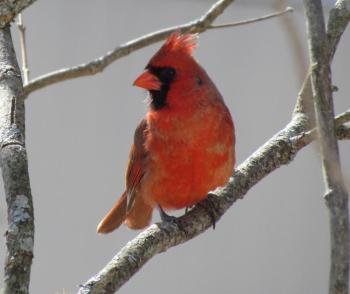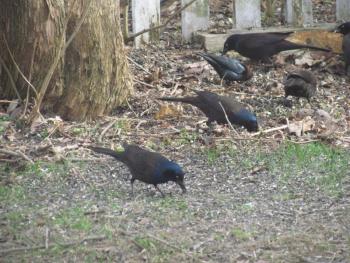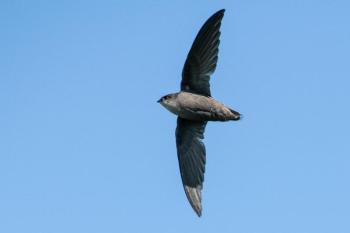Summer Sex and Other Surprises
June in Maine is when the miracle of new life abounds in birds. Most of the birds that breed in Maine—build nests, lay eggs, nurture their young—do so in June. This year, we have been happy to see many young birds successfully out of the nest and being fed by their parents throughout the month. We’ve seen recently fledged young song sparrows, chipping sparrows, northern cardinals, tree swallows, barn swallows, European starlings, common grackles, American robins, house sparrows, American crows, northern ravens, barred owls, and probably a few others that we’ve forgotten.
Now that July is upon us, with its heat and humidity, we have been fascinated by the idea that birds may still be nesting or raising young through these difficult conditions. Some bird species almost never nest this late in the year. Birds like common grackles are among the earliest spring arrivals here in Maine, though a few in spend the winter here. They nest early, and sometimes their young have fledged by late May or early June. We noticed young grackles being fed in our neighborhood by early June this year. Despite their early arrival dates and early nesting, they raise only a single brood each year. The Baltimore oriole, likewise, only raises a single brood. Perhaps that’s why they seem to disappear after mid-July as they stop singing and cease other activities that make them conspicuous.
Other bird species regularly have more than one brood in a season. Predictably, these tend to be among the most abundant and widespread species. Mourning doves can breed multiple times a season in many areas. They are one of the most abundant birds in North America, with an estimated population of 350 million or more. American robins can raise more than one brood a season. They are thought to number at least 370 million. With the increasingly earlier springs and later falls, northern cardinals can sometimes raise more than one family here in Maine as they often do farther south. Their total population is said to be over 100 million.
But most birds only nest once each season, unless they lose their nest early enough to pursue another attempt. The small resurgence in song activity in birds in early July may come from multiple nesting species including cardinals and robins as well as from single-nesting birds that have lost nests earlier in the season and are trying to squeeze in some success before they have to migrate south.
We have been seeing some curious behavior in chimney swifts—the famous “flying cigars” that spend summers here—in recent days. The behavior appears to be related to nesting, or at least it is reminiscent of their breeding behavior. Chimney swifts famously make their nests by snapping off tiny twigs in flight from the tops of trees, taking them into a chimney (or, more rarely nowadays, into an old hollow tree) and gluing the twigs to the wall of the chimney with their sticky saliva to make a tiny cup. They arrive from their Amazonian wintering grounds in late May and start nesting soon after arrival. The young should be fledging here by mid-July.
So we were surprised when we noticed multiple chimney swifts flying repeatedly into the top of a tree in the neighborhood during the first week of July in classic twig-gathering behavior. We were immediately filled with questions. Would chimney swifts really be building new nests this late in the year? Do they ever add to existing nests later in the year? Are there non-breeding birds in their first year that practice building nests?
After a little online searching in Birds of the World, we learned that swift nests can be destroyed or damaged by heavy rains. Maybe some have had nests lost from bad weather and are trying to rebuild and renest as quickly as possible. Some, presumably birds in their first year, occasionally serve as helpers at the nest of nesting pairs. Maybe these young birds practice twig-gathering and nest-building so that they’ll be ready for nesting next year. The most fascinating idea that we came across was from a short paper published in 1945 in which the author reported seeing chimney swifts doing the same thing that we observed—only he witnessed it in Quebec’s Gaspe Peninsula in July and August of 1937. He wondered if they were actually engaging in a form of play behavior!
What surprises await us next in these hot days of summer?
Jeffrey V. Wells, Ph.D., is a Fellow of the Cornell Lab of Ornithology and Vice President of Boreal Conservation for National Audubon. Dr. Wells is one of the nation's leading bird experts and conservation biologists. He is a coauthor of the seminal “Birds of Maine” book and author of the “Birder’s Conservation Handbook.” His grandfather, the late John Chase, was a columnist for the Boothbay Register for many years. Allison Childs Wells, formerly of the Cornell Lab of Ornithology, is a senior director at the Natural Resources Council of Maine, a nonprofit membership organization working statewide to protect the nature of Maine. Both are widely published natural history writers and are the authors of the popular books, “Maine’s Favorite Birds” (Tilbury House) and “Birds of Aruba, Bonaire, and Curaçao: A Site and Field Guide,” (Cornell University Press).
































.png)
.png)
